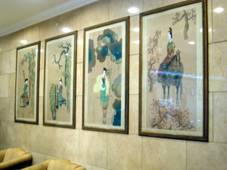 Photo 1
Photo 1
This set of four seasons paintings on display in a hotel lobby in Shanghai, China are evidence of the strong western influence found all over Asia.
When visiting the far east, European influence on Asian culture is seen everywhere from Starbucks and jeans to wall decor. Hotels and public buildings feature traditional and contemporary artwork intermixed with eclectic interior design (photo 1). Just as American designers and framers have changed their thinking about what a mat should be, Asian art, design, and scroll mounting continues to be impacted by western framing. A high end frame shop in Shanghai features western moulding samples on the wall, paper mats, and bins full of open edition prints from western publishers and artists (photo 2).
 Photo 1
Photo 1
This set of four seasons paintings on display in a hotel lobby in Shanghai, China are evidence of the strong western influence found all over Asia.
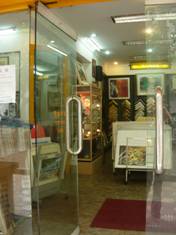 Photo 2
Photo 2
This frame shop features western moulding samples on the back wall and bins full of open edition prints from westerns artists. Framed samples have both paper mats and pasted brocade accent edging.
Window Mats
Mats come in many sizes, shapes, styles and colors. They may be cut as windows which traditionally lay on top of the edges of an item, or may be used as a contrasting color mount board with a flat mounted piece suspended in the center. They may be of comprised of paper, leather, stone, or fabric and their reinvention has been the source of innovative design for decades.
Asian versions of western mats are made of decorative and handmade papers mounted to the face or back edge of the original art (photo 3). Asian ink and watercolor paintings, stone rubbings, silk embroidery, and batik are backed and traditionally mounted as scrolls, though contemporary thinking also offers them as framed and glassed art (photo 4). There is little reference to, or understanding of, preservation, and paper edged art is usually pressed directly against glass, if glazed at all. Since scrolls are never under glass it is perfectly acceptable not to glaze an edged image.
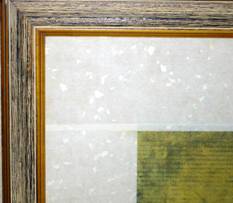 Photo 3
Photo 3
This corner detail of a pasted accent mat from photo 1 clearly shows the surface edge of mounted decorative handmade paper used as a mat to surround the original painting.
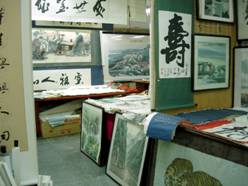 Photo 4
Photo 4
Unmounted backed art (tables), hanging mounted scrolls ready to sell, and brocade edged art under glass are ready for sale.
Backed and Edging
Backing and edging is a common practice in Asia. The backing of completed art with another layer of kozo paper is usually completed by the artist and is a requirement prior to scroll mounting or placing in a frame. Backing with paper is the only way to flatten water soaked mulberry paper that has cockled. It also strengthens the paper by doubling its thickness, and intensifies the painted inks and colors. The additional application of strips of contrasting fabric surrounding a kozo backed painting are designed for accent and to help protect the edges of the original art when handled (photo 5). The contrasting color is designed as a visual accent and enhancement, not unlike western window mats.
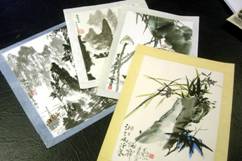 Photo 5
Photo 5
These are samples of kozo art bought backed over 50 year old in China. The contrasting edging is designed as an accent and to help protect the edges of the original art when handled.
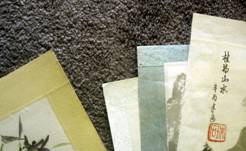 Photo 6
Photo 6
Strips are glued to outer ⅛" edge of either the face of the backed art (L) or the back of the art (R) with fabric or decorative papers. The center right blue edging is paper while all others are silk brocade.
Edging, or brocade matting, may be pasted to either the front or the back by overlapping outer ⅛" edges of the painting using starch paste and decorative papers or silk fabrics (photo 6). Solid or patterned papers may be used for these decorative edges. Bamboo and gampi papers are favored for the solids, while patterned block prints, screen prints, hand painted papers, and woven silks are used for patterns. Japanese decorative papers and printed cotton fabrics are often used as accent strip since bold patterns can be too overwhelming for the art (photo 7). The most common fabrics include silk gauze, plain woven silk, patterned brocade, raw silk, and satin (photo 8).
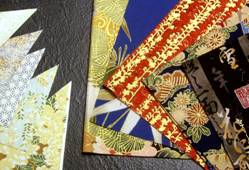 Photo 7
Photo 7
Japanese decorative sheets from $15-20. (L) are good for the accent strip top and bottom. The Japanese fabrics (R) and woven silks are used for patterns.
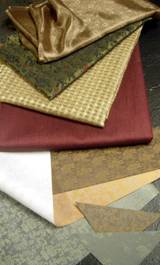 Photo 8
Photo 8
Fabric yardage from top are silk gauze, woven patterned silk, midweight brocade, and raw silk. Bottom are paper backed silk sheer in five assorted patterns and colors.
Brocade Matting
When a customer returns from the Beijing Summer Olympics with an unframed/unmounted rice paper treasure, they will likely want it scroll mounted, but this is a skill most western framers do not have and a technique nearly impossible to teach. Mounting the art with starch paste onto AF foam center board then surrounding it with brocade fabric edging is a possible alternative to traditional scroll mounting by creating the look of the tradition with a western twist. This is known as Contemporary Brocade Matting.
The silk used for edging is available in a number of weights from gauze to heavy brocade. All fabric is sold by the meter, but the brocade and unbacked silk gauze for scrolls is only sold in Asian art and scroll shops (photo 9). Unbacked fabrics brocade, raw and sheer silk may all be manually backed using the same method as kozo backing mulberry paper and folded art, but it is time intensive and takes up a lot of space. See The Mounting And Laminating Handbook, 3rd Edition "Kozo Mounting", available at PFM PubCo.
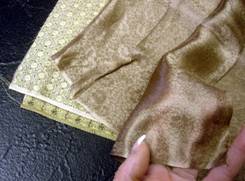 Photo 9
Photo 9
Sheer lightweight silk is highly prone to static and snagging and is so thin my fingers are visible through it. The heavier gold patterned midweight brocade shown both sides (L) is easier to handle by still needs to be backed prior to mounting.
Paper backed brocade is sold in rolls, by the meter, or by the sheet by assorted American importers of art and sumi supplies, but may easily run $50.-75. per sheet if purchased in the USA. Japanese papers run $15-30. per sheet 18x24" sheet if not hand painted.
Asian Proportions
Basic reasoning behind a narrower side with wider top and bottom are to help maintain the elongation of the original art with the outer dimensions of the frame or scroll. When sides of a mat are weighted to match top and bottom, the ratio of top to side is altered. Sample #1 has a ratio of 1:3 while #2 has the same size art but the ratio is now 1:2, more rectangular. Sample #3 is almost 1:1 square, while #4 once again is about 1:2 and rectangular (diagram 1).
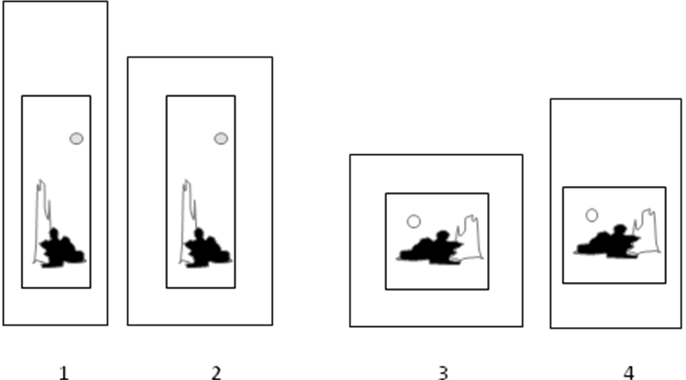 Diagram 1
Diagram 1
Assuming the art has been properly backed, all four sides must be cleanly trimmed and verified for square prior to measurements. Then calculate the widths and length of sides, top (heaven), and bottom (earth) using Asian proportions. Asian proportions are based on historic scrolls allowing 30 percent of the finished picture as painting and 70 percent as brocade trim. Basic proportions of the silk above the painting is ⅔ of the total with the other ⅓ of the total below the painting. Heaven above (the art) is twice as wide as earth below. The side panels for contemporary mountings are often about half of the width of earth.
For more in-depth information on backing, proportions, and traditional scroll mounting see Mastering Mounting, "Japanese Scroll Mounting", PFM May 2001, and "Chinese Scrolls: P1-Backing and P2-Mounting", July-August 2005.
When adding patterned silk as a decorative mat proportions may be either eastern or western. The left sample illustrates Asian proportions typical of a scroll. The right sample is a squared western influenced version with all four sides of equal width. The dark line is the accent strip often in gold or silver. Either may be displayed as a gallery wrap or in a frame (diagram 2).
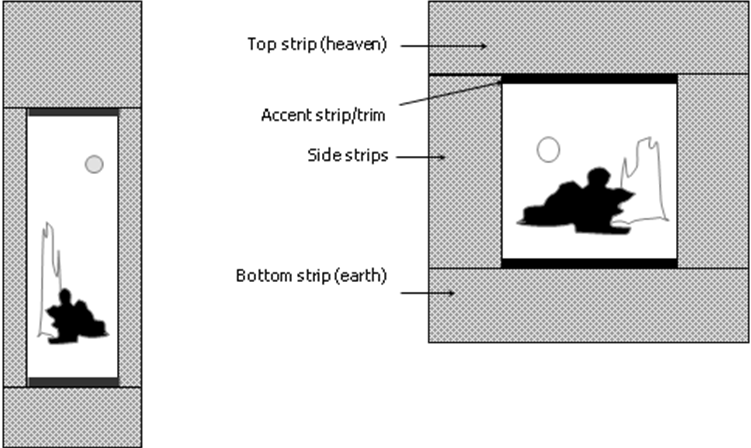 Diagram 2
Diagram 2
Preparation
A sheet of ½" foam center board is preferred as the substrate for brocade mats (photo 10). It is rigid and thick enough to be left unframed or as a ready to frame unit. A 3/16" sheet is too thin to give any side width as a gallery wrap and is less likely to warp, even if framed. Though other more rigid products like Bienfang MightyCore or Gatorboard might not warp they do not have the width to stand alone.
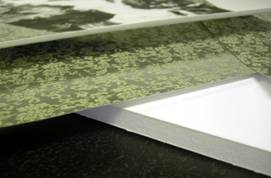 Photo 10
Photo 10
The substrate of choice is ½" foam board for thickness and rigidity. Shown is backed art (top), brocade pieces cut to size and Bainbridge foam board base.
The silk brocade will be glued to the surface of the foam board but then will be wrapped around the ½" edge of the foam to the back. Allowances need to be made for fabric for that wrap. If it is known the brocade mat is to be placed in a frame this extra fabric is not necessary.
Step by Step and Diagram 3
1)Carefully measure and draw light pencil lines on the foam base to mark the placement of the art and each of the brocade pieces, making sure to accommodate for overlapping ⅛" seams, and cut pieces to size (photo 11). The paper backing prevents the edges of the silk from fraying though pay attention when gluing to not trap a loose thread under the silk.
2)For adhering the art, apply the starch paste or wet glue directly to the backing board. All other glue will be applied to the strips. Align the glue coated art to the foam board, cover with Kraft paper and smooth with soft rubber roller. All other paste will be applied to each individual piece rather than the board because of overlapped seams and gallery wrapping.
3)Apply paste the back of sized gold contrast strip and align above the mounted art overlapping the outer ⅛" edge of the mounted art . Cover with clean paper and burnish to adhere. Repeat for bottom accent strip of gold accent.
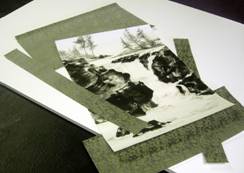 Photo 11
Photo 11
All pieces sized for this brocade mat are done for a framed mount and not a gallery wrap. The extra wrap dimensions were eliminated from the measurements. The 2-½" side strips will just come to the edge of the foam and not wrap the edge.
4)Apply paste to the back of the left side strip. Align the wet strip by overlapping art and gold accent strip by ⅛" (photo 12), and verify that alignment by checking the pencil lines. If the brocade is to be gallery wrapped, by applying the paste directly to the paper backed silk allows it to be immediately pressed around the edges to the back of the board. Cover with clean Kraft paper and press with roller or burnish with a bone along the ½" side edge and back. Repeat the above steps to apply the right side strip, concluding with wrapping and burnishing to the back.
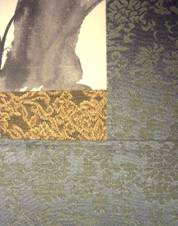 Photo 12
Photo 12
All strips are evenly overlapped ⅛", and seams are always a visible part of the design. Since brocade has a nap and the sheen will change when a piece is inverted, so all strips must be cut the length of the sheet and the top must remain the top.
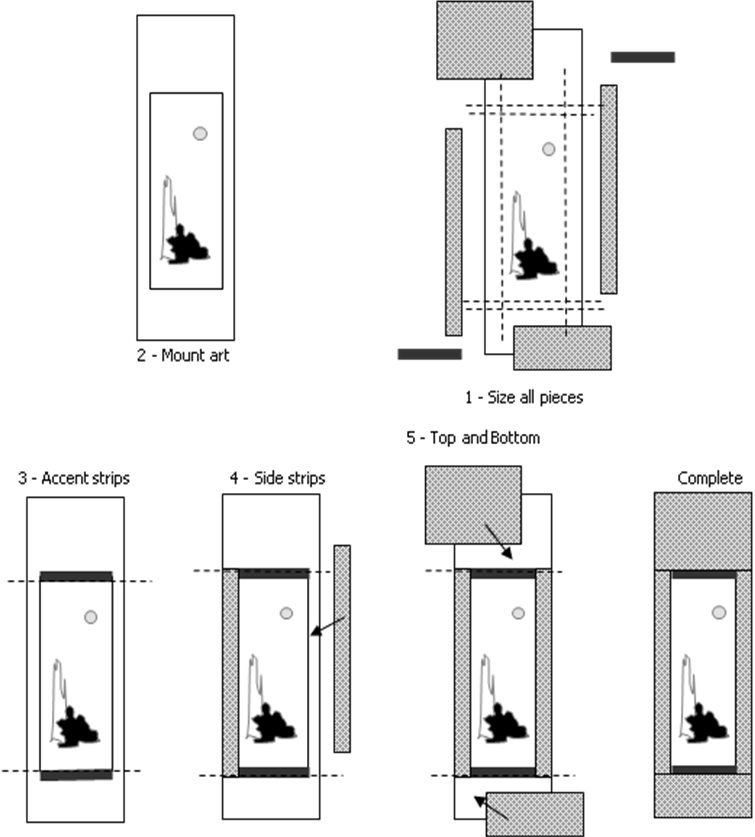 Diagram 3
Diagram 3
5)Apply paste to top strip and align by overlapping gold accent and top edge of side strip ⅛". Cover and burnish to hold. The top and bottom pieces will be applied relatively the same but the corners will need to be neatly folded and tucked as when stretching a canvas corner (photo 13). Repeat application for final bottom strip.
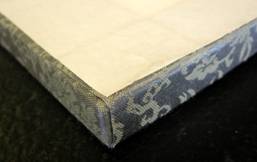 Photo 13
Photo 13
The original contemporary brocade mat is designed as a gallery wrap presentation, so all four sides are wrapped to the back of the foam base. The top and bottom strips will need to have the corners neatly folded and tucked as shown.
The folded and wrapped back flaps must be covered with a final full sheet of kozo to protect the edges from lifting or the fabric from fraying, and to give it a finished appearance (photo 14). Unlike the western tradition of a dust cover only glued or taped at the outer edges, the Asian way is to mount the entire back with a final sheet of heavier kozo for support as was done on this project. This is also done with rolled scrolls. No additional dust cover would be used for this.
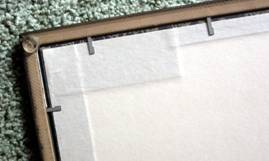 Photo 14
Photo 14
A full sheet of kozo backing is pasted entirely to the back to cover all wrapped edges and to protect fabric from raveling. It is not just glues around the edges like a dust cover, it is a major element of the mount.
This sample project was placed in a beautiful ¾" green bamboo moulding rather than hung as a gallery wrap. The frame is Max Moulding #8109274 and measures 8x30". The completed contemporary brocade mat is displayed unglazed as is common for these and traditional scrolls (photo 15). They only use glass some of the time and it is always pressed directly against the art when used in Asia. Glass could be added to the project if a spacer was inserted to keep it from touching the calligraphy.
 Photo 15
Photo 15
"Every Day is a Good Day" is framed in an 8x30" green bamboo profile #8109274 from Max Moulding. It is unglazed as a scroll would be, but could have glazing applied if a spacer was added. Calligraphy shown compliments of Chris A. Paschke.
END
Copyright © 2008 Chris A Paschke
For more articles on mounting basics look under the mounting section in Articles by Subject.
Additional information on all types of mounting is found in:
The Mounting and Laminating Handbook, Second Edition, 2002,
The Mounting And Laminating Handbook, Third Edition, 2008 and
Creative Mounting, Wrapping, And Laminating, 2000 will teach you everything you need to know about getting the most from your dry mount equipment and materials as an innovative frame designer.
All books are available from Designs Ink Publishing through this website.
Chris A Paschke, CPF GCF
Designs Ink
Designs Ink Publishing
785 Tucker Road, Suite G-183
Tehachapi, CA 93561
P 661-821-2188
chris@designsinkart.com